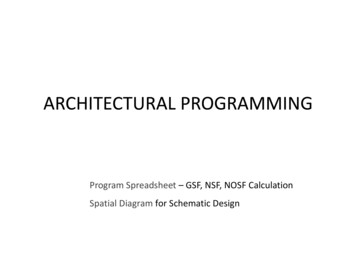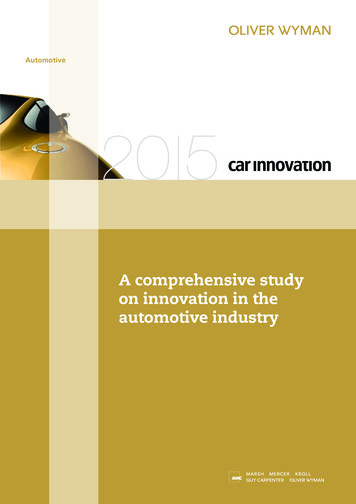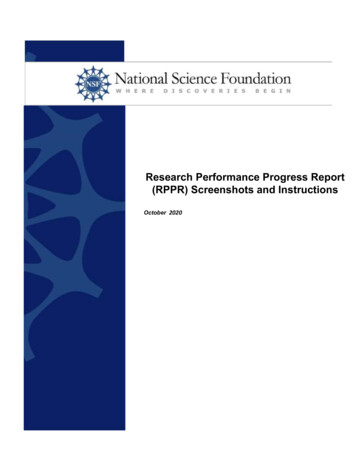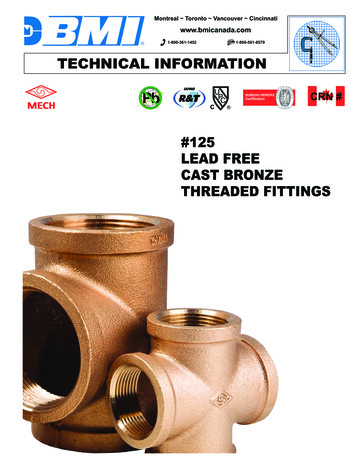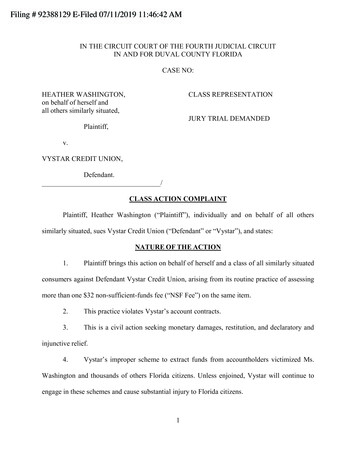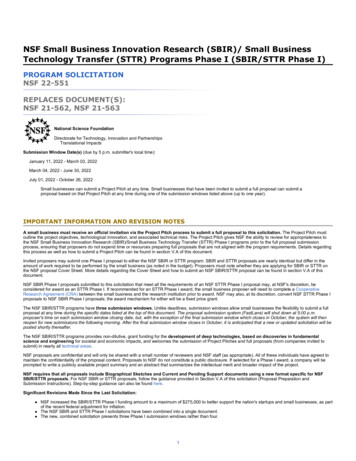
Transcription
NSF Small Business Innovation Research (SBIR)/ Small BusinessTechnology Transfer (STTR) Programs Phase I (SBIR/STTR Phase I)PROGRAM SOLICITATIONNSF 22-551REPLACES DOCUMENT(S):NSF 21-562, NSF 21-563National Science FoundationDirectorate for Technology, Innovation and PartnershipsTranslational ImpactsSubmission Window Date(s) (due by 5 p.m. submitter's local time):January 11, 2022 - March 03, 2022March 04, 2022 - June 30, 2022July 01, 2022 - October 26, 2022Small businesses can submit a Project Pitch at any time. Small businesses that have been invited to submit a full proposal can submit aproposal based on that Project Pitch at any time during one of the submission windows listed above (up to one year).IMPORTANT INFORMATION AND REVISION NOTESA small business must receive an official invitation via the Project Pitch process to submit a full proposal to this solicitation. The Project Pitch mustoutline the project objectives, technological innovation, and associated technical risks. The Project Pitch gives NSF the ability to review for appropriateness tothe NSF Small Business Innovation Research (SBIR)/Small Business Technology Transfer (STTR) Phase I programs prior to the full proposal submissionprocess, ensuring that proposers do not expend time or resources preparing full proposals that are not aligned with the program requirements. Details regardingthis process as well as how to submit a Project Pitch can be found in section V.A of this document.Invited proposers may submit one Phase I proposal to either the NSF SBIR or STTR program. SBIR and STTR proposals are nearly identical but differ in theamount of work required to be performed by the small business (as noted in the budget). Proposers must note whether they are applying for SBIR or STTR onthe NSF proposal Cover Sheet. More details regarding the Cover Sheet and how to submit an NSF SBIR/STTR proposal can be found in section V.A of thisdocument.NSF SBIR Phase I proposals submitted to this solicitation that meet all the requirements of an NSF STTR Phase I proposal may, at NSF's discretion, beconsidered for award as an STTR Phase I. If recommended for an STTR Phase I award, the small business proposer will need to complete a CooperativeResearch Agreement (CRA) between the small business and the research institution prior to award. NSF may also, at its discretion, convert NSF STTR Phase Iproposals to NSF SBIR Phase I proposals; the award mechanism for either will be a fixed price grant.The NSF SBIR/STTR programs have three submission windows. Unlike deadlines, submission windows allow small businesses the flexibility to submit a fullproposal at any time during the specific dates listed at the top of this document. The proposal submission system (FastLane) will shut down at 5:00 p.m.proposer's time on each submission window closing date, but, with the exception of the final submission window which closes in October, the system will thenreopen for new submissions the following morning. After the final submission window closes in October, it is anticipated that a new or updated solicitation will beposted shortly thereafter.The NSF SBIR/STTR programs provides non-dilutive, grant funding for the development of deep technologies, based on discoveries in fundamentalscience and engineering for societal and economic impacts, and welcomes the submission of Project Pitches and full proposals (from companies invited tosubmit) in nearly all technical areas.NSF proposals are confidential and will only be shared with a small number of reviewers and NSF staff (as appropriate). All of these individuals have agreed tomaintain the confidentiality of the proposal content. Proposals to NSF do not constitute a public disclosure. If selected for a Phase I award, a company will beprompted to write a publicly available project summary and an abstract that summarizes the intellectual merit and broader impact of the project.NSF requires that all proposals include Biographical Sketches and Current and Pending Support documents using a new format specific for NSFSBIR/STTR proposals. For NSF SBIR or STTR proposals, follow the guidance provided in Section V.A of this solicitation (Proposal Preparation andSubmission Instructions). Step-by-step guidance can also be found here.Significant Revisions Made Since the Last Solicitation:NSF increased the SBIR/STTR Phase I funding amount to a maximum of 275,000 to better support the nation's startups and small businesses, as partof the recent federal adjustment for inflation.The NSF SBIR and STTR Phase I solicitations have been combined into a single document.The new, combined solicitation presents three Phase I submission windows rather than four.1
A new required format has been instituted for Biographical Sketches and Current & Pending Support documents in NSF SBIR/STTR proposals.Pricing and other documentation to support budget estimates is now not required in the initial proposal submission.Letters of Commitment from consultants and subawardees should be included in the "Other Supplementary Documents" section, rather than theBudget Justification.The project Budget Justification and subaward Budget Justifications are now limited to five pages.Only one Project Pitch submission is permitted per applicant small business per submission window.The format and content of the "Elevator Pitch" section of the Project Description have been modified.For the purpose of this solicitation, the following definitions apply:Funding Agreement: As used in this solicitation, the funding agreement is a Grant – a legal instrument of financial assistance between NSF and anawardee, consistent with 31 USC 6302-6305 and as noted in the NSF Proposal & Award Policies Guide (PAPPG) Introduction, Section D ("Definitions& NSF-Grantee Relationships").Small Business Concerns (SBCs): SBCs are independently owned and operated businesses that are not dominant in the field of operation. For thissolicitation, firms qualifying as a small business concern are eligible to participate in the SBIR/STTR program (see Section IV. "Eligibility Information" ofthis solicitation for more details). Please note that the size limit of 500 employees includes affiliates. The firm must be in compliance with the SBASBIR/STTR Policy Directive and the Code of Federal Regulations (13 CFR 121).SBIR/STTR Data: As defined by the SBA SBIR/STTR Policy Directive, SBIR/STTR Data is all Data developed or generated in the performance of anSBIR or STTR award, including Technical Data and Computer Software developed or generated in the performance of an SBIR or STTR award. Theterm does not include information incidental to contract or grant administration, such as financial, administrative, cost or pricing or managementinformation.SBIR/STTR Data Rights: As noted in the SBA SBIR/STTR Policy Directive, the Federal Government may, use, modify, reproduce, perform, display,release, or disclose SBIR/STTR Data that are Technical Data within the Government; however, the Government shall not use, release, or disclose thedata for procurement, manufacturing, or commercial purposes; or release or disclose the SBIR/STTR Data outside the Government except as permittedby paragraph 10(B) of the SBIR/STTR Policy Directive's Data Rights Clause or by written permission of the Awardee.Research and Development (R&D): broadly defined in 2 CFR § 200.8, but specified for the NSF SBIR/STTR program as follows:the application of creative, original and potentially transformative concepts to systematically study, create, adapt, or manipulate the structureand behavior of the natural or man-made worlds;the use of the scientific method to propose well-reasoned, well-organized activities based on sound theory, computation, measurement,observation, experiment, or modeling;the demonstration of a well-qualified individual, team, or organization ready to deploy novel methods of creating, acquiring, processing,manipulating, storing, or disseminating data or metadata; and/orthe novel integration of new theories, analysis, data, or methods regarding cognition, heuristics, and related phenomena.Deep Technologies: technologies based on discoveries in fundamental science and engineering.Non-Dilutive Funding: financing that does not involve equity, debt, or other elements of the business ownership structure.Technical Risk: Technical risk assumes that the possibility of technical failure exists for an envisioned product, service, or solution to be successfullydeveloped. This risk is present even to those suitably skilled in the art of the component, subsystem, method, technique, tool, or algorithm in question.Technical Innovation: Technical innovation indicates that the new product or service is differentiated from current products or services; that is, thenew technology holds the potential to result in a product or service with a substantial and durable advantage over competing solutions on the market. Italso generally provides a barrier to entry for competitors. This means that if the new product, service, or solution is successfully realized and brought tothe market, it would be difficult for a well-qualified, competing firm to reverse-engineer or otherwise neutralize the competitive advantage generated byleveraging fundamental science or engineering research techniques.Effective February 28, 2022, NSF will transition from DUNS numbers to the New System for Award Management (SAM) Unique Entity Identifier (UEI) inNSF systems. See the forthcoming NSF Advisory Page for more details.Any proposal submitted in response to this solicitation should be submitted in accordance with the revised NSF Proposal & Award Policies & Procedures Guide(PAPPG) (NSF 22-1), which is effective for proposals submitted, or due, on or after October 4, 2021.SUMMARY OF PROGRAM REQUIREMENTSGeneral InformationProgram Title:Small Business Innovation Research (SBIR) / Small Business Technology Transfer (STTR) Program Phase I (SBIR/STTR Phase I)Synopsis of Program:Introduction to the Program:The NSF SBIR/STTR programs focus on transforming scientific discovery into products and services with commercial potential and/or societalbenefit. Unlike fundamental or basic research activities that focus on scientific and engineering discovery itself, the NSF SBIR/STTR programssupport the creation of opportunities to move fundamental science and engineering out of the lab and into the market or other use at scale,through startups and small businesses representing deep technology ventures.The NSF SBIR/STTR programs fund research and development. The programs are designed to provide non-dilutive funding at the earlieststages of technology development.Synopsis of Program:The NSF SBIR/STTR programs support moving scientific excellence and technological innovation from the lab to the market. By investingfederal research and development funds into startups and small businesses, NSF hopes to build a strong national economy and stimulate the2
creation of novel products, services, and solutions in the private sector; strengthen the role of small business in meeting federal research anddevelopment needs; increase the commercial application of federally supported research results; and develop and increase the US workforce,especially by fostering and encouraging participation by socially and economically disadvantaged and women-owned small businesses.The NSF SBIR/STTR programs solicit proposals from small businesses based on groundbreaking scientific discoveries or significantengineering breakthroughs consistent with NSF's mission to promote the progress of science; to advance the national health, prosperity, andwelfare; and to secure the national defense.The programs are governed by Public Law 114-328 (SBIR/STTR Reauthorization Act of 2017). SBIR/STTR policy is provided by the SmallBusiness Administration (SBA) through SBIR/STTR Policy Directive.The NSF SBIR/STTR programs welcome proposals from many topics and do not have a specific technological focus. SBIR/STTR ProgramDirectors work together in "clusters" around general areas of science, engineering or technology to manage proposals and the merit reviewprocess. These clusters encompass Biological and Life Sciences; Mathematics and Physical Sciences; Data and Computer Sciences; andResilient and Sustainable Systems. The topics within each cluster are detailed on the program website, but are only meant to be suggestive ofthe types of topic areas that are anticipated. The program is also open to proposals focusing on technical and market areas not explicitly notedin the aforementioned topics; such proposals should be submitted to "Other Topics". However, the NSF SBIR/STTR programs do not supportclinical trials or proposals from companies whose commercialization pathway involves the production, distribution or sale by the company ofchemical components, natural or synthetic variations thereof, or other derivatives related to Schedule I controlled substances.Cognizant Program Officer(s):Please note that the following information is current at the time of publishing. See program website for any updates to the points of contact.Henry Ahn, Biological and Life Sciences Cluster Lead - Biomedical (BM) Technologies, telephone: (703) 292-7069, email: hahn@nsf.govErik Pierstorff, Biological Technologies (BT), telephone: (703) 292-2165, email: epiersto@nsf.govKaitlin Bratlie, Pharmaceutical Technologies (PT), telephone: (703) 292-2638, email: kbratlie@nsf.govEdward Chinchoy, Medical Devices (MD), telephone: (703) 292-7103, email: echincho@nsf.govPeter S. Atherton, Data and Computer Sciences Cluster Lead - Advanced Analytics (AA); Artificial Intelligence (AI); Cloud and High-PerformanceComputing (CH); Cybersecurity and Authentication (CA); and Quantum Information Technologies (QT), telephone: (703) 292-8772, email:PATHERTO@nsf.govAlastair Monk, Digital Health (DH), telephone: (703) 292-4392, email: amonk@nsf.govDiane Hickey, Augmented and Virtual Reality (AV); Learning and Cognition Technologies (LC); and Human-Computer Interaction (HC), telephone:(703) 292-8875, email: dhickey@nsf.govBenaiah D. Schrag, Mathematics and Physical Sciences Cluster Lead - Instrumentation and Hardware Systems (IH); and Other Topics (OT),telephone: (703) 292-8323, email: bschrag@nsf.govMuralidharan S. Nair, Internet of Things (I); Power Management (PM); Robotics (R); Space Technologies (SP); and Wireless Technologies (W),telephone: (703) 292-7059, email: mnair@nsf.govRajesh V. Mehta, Resilient and Sustainable Systems Cluster Lead - Environmental Technologies (ET); Advanced Materials (AM); and Nanotechnology(N), telephone: (703) 292-2174, email: rmehta@nsf.govElizabeth Mirowski, Advanced Manufacturing (M); Mobility (MO); Photonics (PH); and Semiconductors (S), telephone: (703) 292-2936, email:emirowsk@nsf.govAnna S. Brady-Estevez, Chemical Technologies (CT); Energy Technologies (EN); and Distributed Ledger (DL), telephone: (703) 292-7077, email:abrady@nsf.govApplicable Catalog of Federal Domestic Assistance (CFDA) Number(s):47.041 --- Engineering47.049 --- Mathematical and Physical Sciences47.050 --- Geosciences47.070 --- Computer and Information Science and Engineering47.074 --- Biological Sciences47.075 --- Social Behavioral and Economic Sciences47.076 --- Education and Human Resources47.079 --- Office of International Science and Engineering47.083 --- Office of Integrative Activities (OIA)47.084 --- NSF Technology, Innovation and PartnershipsAward InformationAnticipated Type of Award: Standard GrantEstimated Number of Awards: 60 to 300Approximately 250 to 300 estimated awards for SBIR Phase I per year, pending the availability of funds.Approximately 60 estimated awards for STTR Phase I per year, pending the availability of funds.Anticipated Funding Amount: 15,000,000 to 70,000,000Approximately 70,000,000 for SBIR Phase IApproximately 15,000,000 for STTR Phase IEstimated program budget, number of awards and average award size/duration are subject to the availability of funds.Eligibility InformationWho May Submit Proposals:3
Proposals may only be submitted by the following:Firms qualifying as a small business concern are eligible to participate in the NSF SBIR/STTR program (see Eligibility Guide for moreinformation). Please note that the size limit of 500 employees includes affiliates. The firm must be in compliance with theSBIR/STTR Policy Directive(s) and the Code of Federal Regulations (13 CFR Part 121). For STTR proposals, the applicant smallbusiness must also include a partner research institution in the project, see additional details below; ANDFirms that have received an official invitation to submit a proposal from the cognizant NSF SBIR/STTR Program Director within thepast twelve months. To receive the invitation, potential proposers must submit a Project Pitch document and receive an officialresponse (via email) from the cognizant Program Director. Please see section V.A for details.Who May Serve as PI:The primary employment of the PI must be with the small business concern at the time of award and for the duration of the award, unless anew PI is named. Primary employment is defined as at least 51 percent employed by the small business. NSF normally considers a full-timework week to be 40 hours and considers employment elsewhere of greater than 19.6 hours per week to be in conflict with this requirement.The PI must have a legal right to work for the proposing company in the United States, as evidenced by citizenship, permanent residency, oran appropriate visa. The PI does not need to be associated with an academic institution. There are no PI degree requirements (i.e., the PI isnot required to hold a Ph.D. or any other degree). A PI may be primarily employed at another organization at the time of submission, as longas he or she is primarily employed at the proposing small business at the time of award. A PI must devote a minimum of one calendar monthof effort per six months of performance to an NSF SBIR/STTR Phase I project.Limit on Number of Proposals per Organization: 1An organization may submit one NSF SBIR/STTR Phase I proposal per submission window (e.g., January 11, 2022 – March 3, 2022). Anorganization must wait for a determination from NSF (e.g., Award, Decline, or Returned Without Review) on the pending NSF SBIR/STTRPhase I proposal before submitting a new proposal in the next window. This eligibility constraint will be strictly enforced. In the event that anorganization exceeds this limit, the first proposal received will be accepted, and any additional proposals submitted will be Returned WithoutReview. Declined proposals require a new invitation to submit (via the Project Pitch process) and significant revision, while proposalsReturned Without Review may be submitted using the same invited Project Pitch (assuming that the proposal is received within one year oforiginal the Project Pitch invitation).Limit on Number of Proposals per PI or co-PI: 1For NSF SBIR – 1 PI, co-PIs are not allowed.For NSF STTR - 1 PI, 1 co-PI required (must be part of the partner research institution).An individual may be listed as the PI for only one proposal submitted at a time to this NSF SBIR/STTR Phase I solicitation. A PI must wait for adetermination from NSF (e.g., Award, Decline, or Returned Without Review) on any NSF SBIR/STTR Phase I pending proposal beforesubmitting a new proposal.NSF SBIR proposals may not have co-PIs.For NSF STTR proposals, a person may act as the co-PI on an unlimited number of proposals.Proposal Preparation and Submission InstructionsA. Proposal Preparation InstructionsLetters of Intent: Not requiredPreliminary Proposal Submission: Not requiredFull Proposal Preparation Instructions: This solicitation contains information that deviates from the standard NSF Proposal and Award Policies andProcedures Guide (PAPPG) proposal preparation guidelines. Please see the full text of this solicitation for further information.B. Budgetary InformationCost Sharing Requirements:Inclusion of voluntary committed cost sharing is prohibited.Indirect Cost (F&A) Limitations:Not ApplicableOther Budgetary Limitations:Other budgetary limitations apply. Please see the full text of this solicitation for further information.C. Due DatesSubmission Window Date(s) (due by 5 p.m. submitter's local time):January 11, 2022 - March 03, 2022March 04, 2022 - June 30, 2022July 01, 2022 - October 26, 20224
Small businesses can submit a Project Pitch at any time. Small businesses that have been invited to submit a full proposal cansubmit a proposal based on that Project Pitch at any time during one of the submission windows listed above (up to one year).Proposal Review Information CriteriaMerit Review Criteria:National Science Board approved criteria. Additional merit review criteria apply. Please see the full text of this solicitation for further information.Award Administration InformationAward Conditions:Additional award conditions apply. Please see the full text of this solicitation for further information.Reporting Requirements:Additional reporting requirements apply. Please see the full text of this solicitation for further information.TABLE OF CONTENTSSummary of Program ionProgram DescriptionAward InformationEligibility InformationProposal Preparation and Submission InstructionsA. Proposal Preparation InstructionsB. Budgetary InformationC. Due DatesD. FastLane RequirementsNSF Proposal Processing and Review ProceduresA. Merit Review Principles and CriteriaB. Review and Selection ProcessAward Administration InformationA. Notification of the AwardB. Award ConditionsC. Reporting RequirementsAgency ContactsOther InformationI. INTRODUCTIONThe NSF SBIR/STTR programs focus on transforming scientific discovery into commercial potential and/or societal benefit through the development of productsor services. Unlike fundamental or basic research activities which focus on scientific and engineering discovery itself, the NSF SBIR/STTR programs supportstartups and small businesses in technological innovation; that is, the creation of opportunities to move fundamental science and engineering out of the lab andinto the market.The NSF SBIR/STTR programs fund research and development. The programs are designed to provide non-dilutive grant funding to support startups orentrepreneurs with technologies at the earliest stages of research and development. NSF SBIR/STTR awards are not government contracts. The NSF does notuse its SBIR/STTR programs to procure goods or services for the government, nor does the NSF receive any stake or interest in an awardee firm. By investingfederal research and development funds into startups and small businesses, NSF hopes to build a strong national economy and stimulate the creation of novelproducts, services, and solutions in the private sector; strengthen the role of small business in meeting federal research and development needs; increase thecommercial application of federally supported research results; and develop and increase the US workforce, especially by fostering and encouragingparticipation by socially and economically disadvantaged and women-owned small businesses.The NSF SBIR/STTR programs do not have a specific topical focus. Generally, the topics included in the NSF SBIR/STTR solicitation are intended to be broadenough to permit startups with science- and engineering-based innovations to compete for funding, transforming science and engineering discovery andinnovation into both societal and economic impact. NSF encourages people from all backgrounds and geographic areas to apply for funding. At the conclusion ofthe project, an awardee company must submit a final report to NSF to ensure that the company properly spent NSF funds on approved activities, as originallyproposed. Awardee companies will also need to submit a project outcomes report for the general public. NSF does not purchase these project reports and doesnot benefit from these reports, beyond an oversight function. NSF does not test, verify, or otherwise use the technology developed under its SBIR/STTR awards.The NSF SBIR/STTR Phase I programs are highly competitive. While success rates vary year-to-year, only a fraction of proposals submitted are selected for anaward. Thus, there are many qualified businesses applying to the program each year that do not receive funding.5
II. PROGRAM DESCRIPTIONThe NSF SBIR/STTR programs encourage startups and small businesses to submit proposals across all areas of science and engineering.*While startups and small businesses face many challenges, the NSF SBIR/STTR funding is intended to specifically focus on challenges associated withtechnological innovation; that is, on the creation of new products, services, and other scalable solutions based on fundamental science or engineering. Asuccessful Phase I proposal demonstrates how NSF funding will help the small business create a proof-of-concept or prototype by retiring technical risk.Funding from NSF may only be used to conduct research and development (R&D) to demonstrate technical feasibility.NSF seeks SBIR/STTR proposals that represent success in three distinct, but related merit review criteria: Intellectual Merit, Broader Impacts andCommercialization Potential.The Intellectual Merit criterion encompasses the potential to advance knowledge and leverages fundamental science or engineering research techniques toovercoming technical risk. This can be conveyed through the Research and Development (R&D) of the project. R&D is broadly defined in 2 CFR § 200.8, butspecified for the NSF SBIR/STTR program as follows:the application of creative, original and potentially transformative concepts to systematically study, create, adapt, or manipulate the structure andbehavior of the natural or man-made worlds;the use of the scientific method to propose well-reasoned, well-organized activities based on sound theory, computation, measurement, observation,experiment, or modeling;the demonstration of a well-qualified individual, team, or organization ready to deploy novel methods of creating, acquiring, processing, manipulating,storing, or disseminating data or metadata; and/orthe novel integration of new theories, analysis, data, or methods regarding cognition, heuristics, and related phenomena.NSF SBIR/STTR proposals are often evaluated via the concepts of Technical Risk and Technological Innovation. Technical risk assumes that the possibilityof technical failure exists for an envisioned product, service, or solution to be successfully developed. This risk is present even to those suitably skilled in the artof the component, subsystem, method, technique, tool, or algorithm in question. Technological Innovation indicates that the new product or service isdifferentiated from current products or services; that is, the new technology holds the potential to result in a product or service with a substantial and durableadvantage over competing solutions on the market. It also generally provides a barrier to entry for competitors. This means that if the new product, service, orsolution is successfully realized and brought to the market, it should be difficult for a well-qualified, competing firm to reverse-engineer or otherwise neutralizethe competitive advantage generated by leveraging fundamental science or engineering research techniques.The Broader Impacts criterion encompasses the potential benefit to society and contribution to the achievement of specific, desired societal outcomes asoutlined in the NSF PAPPG Merit Review Broader Impacts Criteria.The NSF SBIR/STTR programs fund the development of new, high-risk technology innovations intended to generate positive societal and economic outcomes.Proposers should also consider the American Innovation and Competitiveness Act (P.L. 114-329, Section 102) Broader Impacts Review Criterion Update:Increasing the economic competitiveness of the United States.Advancing of the health and welfare of the American public.Supporting the national defense of the United States.Enhancing partnerships between academia and industry in the United States.Developing an American STEM workforce that is globally competitive through improved pre-kindergarten through grade 12 STEM education andteacher development, and improved undergraduate STEM education and instruction.Improving public scientific literacy and engagement with science and technology in the United States.Expanding participation of women and individuals from underrepresented groups in STEM.The Commercialization Potential of the proposed product or service is the potential for the resulting technology to disrupt the targeted market segment by wayof a strong and durable value proposition for the customers or users.The proposed product or service addresses an unmet, important, and scalable need for the target customer base.The proposed small business is structured and staffed to focus on aggressive commercialization of the product/service.The proposed small business can provide evidence of good product-market fit (as validated by direct and significant interaction with customers andrelated stakeholders).Administrative Requirements:In addition to the eligibility requirements outlined in Section IV, submission of a full proposal requires that the proposer:Register in the System for Award Management (SAM), Research.gov, and SBIR.gov.To register with SAM, the small business must have a valid DUNS number (or UEI number starting in February 28, 2022 – please refer to "ImportantInformation and Revision Notes" for more details). These registrations take time, so we recommend starting several weeks or a month prior to theproposal deadline; see section V.A.B for details.For more in-depth program information please reference the Program Website and the solicitation-specific Merit Review Criteria in Section VI.* The NSF SBIR/STTR program does not support clinical trials or proposals from companies whose commer
proposer's time on each submission window closing date, but, with the exception of the final submission window which closes in October, the system will then reopen for new submissions the following morning. After the final submission window closes in October, it is anticipated that a new or updated solicitation will be posted shortly thereafter.

